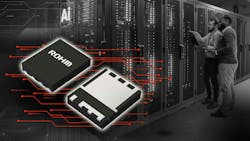N-Channel MOSFETs Meet AI’s Escalating Power Demands
ROHM Semiconductor rolled out new N-channel power MOSFETs that are specifically designed for AI power supplies in data centers.
The company said the lineup is all about cutting power losses by reducing the on-resistance (RDS(on)) of the FETs and increasing reliability by expanding their safe operating area (SOA). The RDS(on), the resistance between the drain and source terminals of the power FET, is one of the most important performance metrics for power devices.
The lineup includes a 30-V MOSFET—the RS7E200BG—that’s optimized for both the secondary-side AC-DC conversion circuits in 12-V server power supplies and 12-V hot-swap controllers used for fault detection and load protection in data centers. In addition, there’s a pair of 80-V power FETs—the RS7N200BH and RS7N160BH—ideal for the secondary AC-DC converter circuits in 48-V server power supplies for AI.
The MOSFET: Where It Fits into AI Power Architectures
The latest graphics processing units (GPUs), such as the Blackwell B100 and B200 at the heart of NVIDIA’s latest AI accelerators, gulp down as much as 1,200 W at peak loads to do training and inferencing.
The situation is driving up the power-per-rack requirements in data centers to more than 100 kW, up from 15 to 30 kW per rack at present. The power-supply units (PSUs) that reside in every column of servers are evolving to make sure more power makes it to the CPUs, GPUs, and other high-performance chips inside. The PSU converts the high-voltage AC (up to 380 V AC) used to convey power to the server rack into the DC bus voltage (typically 12, 48, or 54 V) that delivers power to all servers within the rack itself.
The most widely used power-supply topology includes a power-factor-correction (PFC) stage that feeds into the LLC stage. The growing power demands of AI chips require several outputs with LLC transformers to reduce conduction losses in the secondary windings and synchronous rectifiers. In most cases, these windings are placed in parallel with the synchronous rectifiers to minimize the winding resistance. But that raises termination losses, which can negatively affect the system efficiency as switching frequency rises.
To wring out more efficiency, many power electronics and systems engineers turn to silicon carbide (SiC) and gallium nitride (GaN), which feature faster switching speeds and superior heat dissipation than silicon. These power devices can also help with the highly dynamic power requirements of many AI accelerators, which may require sudden and very large load currents, with currents increasing as fast as 2.5 A/µs at the PSU.
Despite that, 80-V MOSFETs are crucial in the synchronous rectification stage of the PFC and the LLC, where switching losses don’t matter as much. The conduction losses caused by the RDS(on) of silicon MOSFETs in the power block can have a huge impact on a system’s performance and efficiency. ROHM said that’s even more evident in PSUs in data centers, where the conduction losses account for a large portion of the total power loss, driving the demand for power FETs with lower RDS(on).
Low-voltage power MOSFETs are also widely used for hot swapping in data centers, which is all about removing and replacing servers or other building blocks without shutting down the system’s power supply.
However, hot swapping subjects the system to huge amounts of current, posing a risk from the power devices themselves to the processor, accelerators, and any other loads—and everything in between. A hot-swap controller plays one of the most critical roles by regulating the inrush current when powering up and preventing short circuits or other fault conditions during regular operation. Curtailing the inrush current reduces stress on power circuit components, helping to prevent device failure and stabilize the system.
A MOSFET acts as the main power switch in the hot-swap controller. However, it requires a wide SOA to ensure durability and protection of both the power devices and the loads under these conditions.
Reshaping the Power MOSFET for the AI Era
To overcome these challenges, ROHM upgraded the packaging around the power MOSFET to accommodate a larger die than traditional FETs. The more advanced package—the DFN5060-8S—increases the internal die area by around 65% while staying within the same 5- × 6-mm enclosure as the standard HSOP8 package. As a result, ROHM said it significantly reduced the RDS(on) of the power FETs while extending SOA.
In general, a larger power MOSFET will have a smaller amount of resistance between its drain and source. This is primarily because a larger die enables more parallel routes between the drain and source of the FET, thus reducing the resistance to current flow. A larger surface area also helps with heat dissipation, which is more of a concern with high-current power supplies, as high temperatures inside the FET can increase RDS(on).
ROHM stated that its latest 30- and 80-V MOSFETs can deliver on-resistances of 0.53 and 1.7 mΩ (with VGS at 10 V), respectively, bringing significant leaps in efficiency and reliability to server power architectures.
The company said it also improved the internal clip design of the power device to enhance heat dissipation, which makes a significant difference for the SOA of the device under heavier loads. For instance, the 30-V MOSFET can manage more than 10 A of current at a PWM width of 1 ms when the drain to source voltage (VDS) of the power device is 12 V. That’s double what a power MOSFET in the HSOP8 package can tolerate under the same conditions, leading to more robust and reliable operation.
ROHM plans to start mass production of power FETs specifically designed for hot-swap controllers in AI servers later in 2025. In general, AI servers run on the 48- or 54-V DC bus, requiring higher voltage FETs.
About the Author
James Morra
Senior Editor
James Morra is the senior editor for Electronic Design, covering the semiconductor industry and new technology trends, with a focus on power electronics and power management. He also reports on the business behind electrical engineering, including the electronics supply chain. He joined Electronic Design in 2015 and is based in Chicago, Illinois.

